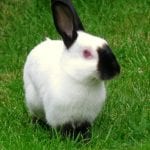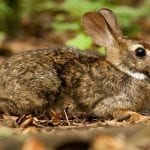Scientific Facts
| Common Name: | Volcano rabbit, teporingo, zacatuche |
| Scientific Name: | Romerolagus diazi |
| Life Span: | 7 to 9 years |
| Size (Adult): | Small |
| Weight (Adult) | 390 to 600 grams |
| Habitat: | Mountainous areas, grass tussocks |
| Body Shape: | Small and compact |
| Country of Origin: | Mexico |
Physical Description
The volcano rabbit is known in its native country of Mexico as the teporingo or the zacatuche. It is the second smallest rabbit species with the pygmy rabbit as the smallest in the world. Adults are very small and weigh only 390 to 600 grams and may live up to 9 years. This species has been classified as endangered or threatened by the IUCN.
The volcano rabbit has small and short hind legs and feet. It also has small and rounded ears with a vestigial tail. The dorsal and lateral fur is yellow-brown, and hairs are black at the tips and the base, and this creates a grizzled look. It has a buff light grey venter.
Similar to all the members of the Leporidae family, it has large, well-positioned eyes that provide a broad viewing angle for the rabbit. The volcano rabbit is known as the most primitive of all the leporids and is sexually dimorphic. Males weigh less than females, with females weighing up to 530 grams.
Newborn volcano rabbits are deaf with closed eyes, laid-back ears, and fine brown fur at the time of birth. The tail is visible in newborns, but it gradually becomes less and less prominent as the rabbit becomes an adult.
The body size and the hind-limb development of the volcano rabbit demonstrate how this rabbit needs a lot of grass cover to escape predators. Unlike other wild rabbits like cottontails and hares, the volcano rabbit is slow and is thus vulnerable to predators, especially in open areas.
Decline, threats and conservation actions

The volcano rabbit is the subject of numerous studies during the 1980s and 1990s, and these studies resulted in the agreement that the rabbit’s natural habitat was dramatically shrinking. This was due to natural and anthropogenic causes. One study showed that the population of volcano rabbits in the last 18,000 years declined due to a 5 to 6 degree Celsius increase in temperature. Also, volcano rabbits are now driven to higher altitudes as a result of the construction of new roads and highways that pass through its habitat.
Some studies also found that the decline in the population of the volcano rabbit is due to changes in vegetation, climate, and elevation. It is a species that’s very vulnerable to the effects of climate change and other intrusions due to its limited range and highly-specialized diet. The vegetation that the volcano rabbit uses for cover has become sparse, and thus, it is more vulnerable to predators.
Fast Facts
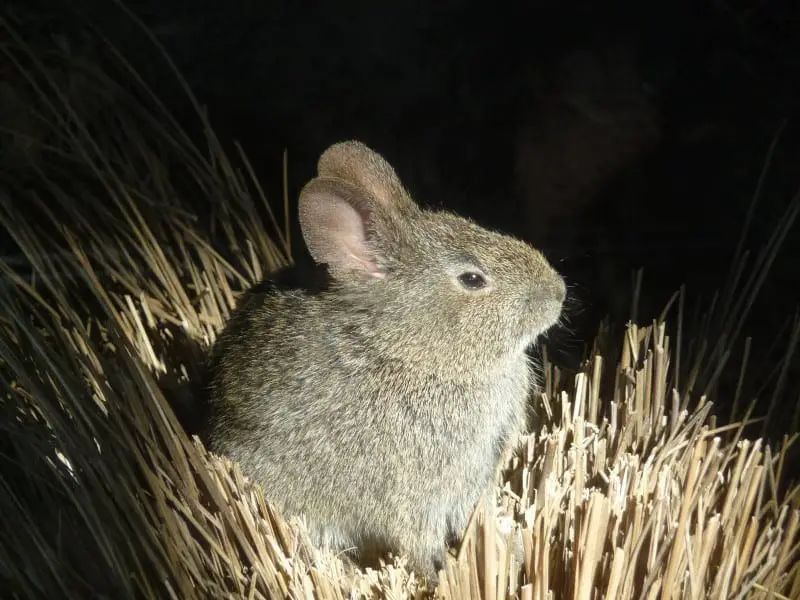
The volcano rabbit is mostly found in areas surrounding Mexico City, Mexico’s capital and the most populous city in the country. This may be one of the reasons why it has suffered a higher rate of habitat destruction more than other wild rabbit species.
The volcano rabbit may also be bred in captivity, but there are studies that it loses genetic diversity when it is reproduced in this condition. A study was made on wild and captive volcano rabbits, and results revealed that captive species had lost a significant amount of DNA loci, with up to 88% losing their genetic variability. Because of this, conservation efforts are still in question.
The threats to the existence of volcano rabbits are logging, livestock grazing, harvesting of grasses, urban expansion, habitat destruction, and highway construction. Lately, unsound management of national parks has also resulted in the decline of the population of volcano rabbits.
Reproduction
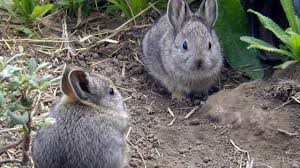
This information was gathered in captive species only. The male and female rabbits communicate with each other using their scent glands located under the chin and in the groin. The scent glands of rabbits are important in mating and are also used in determining their social status.
In captivity, the volcano rabbit mates for life. Mating access is determined by social status, and only the dominant female and dominant male can mate. If the male or the female dies, it is immediately replaced by the highest-ranking rabbit in the hierarchy.
Breeding happens all year and can peak during springtime. Captive females reach sexual maturity at 8 months while captive males are sexually mature by the time they are 5 months old. Gestation lasts from 38 to 40 days, and females will give birth to 1 to 4 babies per litter. Each kit may weigh around 80 grams. Female volcano rabbits may have 4 to 5 litters per year. The offspring are weaned by the time they are 3 weeks old.
Mothers care for their young until they are weaned at 3 weeks. In the wild, the female will dig shallow burrows in clumps of grass, which aim to hide the nest and protect the newborns from predators. The nest is made from fragments of vegetation and fur. Captive volcano rabbits usually give birth to their babies in a nest box and then leave them, only to come back to nurse them in the evening. The female will avoid the nest and will only come back when she hears distress calls coming from her young.
Fun Facts

The volcano rabbit is the only member of the Leporidae family that can vocalize sounds. It reacts to the sound that their babies make and can also make noises when startled, which is similar to pikas. There are two types of calls; one is a high-pitched bark while the other one is a less-audible squeak.
Personality and Behavior
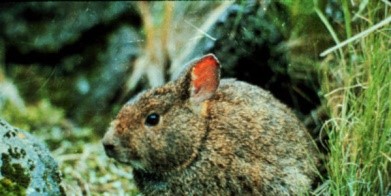
The volcano rabbit is semi-social and lives in groups with 2 to 5 individuals. The groups are usually dominated by the breeding pair, and the breeding female is at the top of the hierarchy. Only the top male and female reproduce. In the group, interactions like play and fights are common.
Dominant females are agonistic towards lower-class males and females, while dominant males are not aggressive. It is active during the day and activity peaks during dawn and dusk. Wild and captive volcano rabbits communicate using calls and by thumping their hind feet.
Comparable Breeds
The volcano rabbit is comparable to the pygmy rabbit. The later is also considered threatened, and thus, conservation efforts have started to breed pygmy rabbits to other surviving small rabbit breeds. The pygmy rabbit may be bred and cared for in captivity but only by patient and experienced individuals.
Care of Volcano rabbits
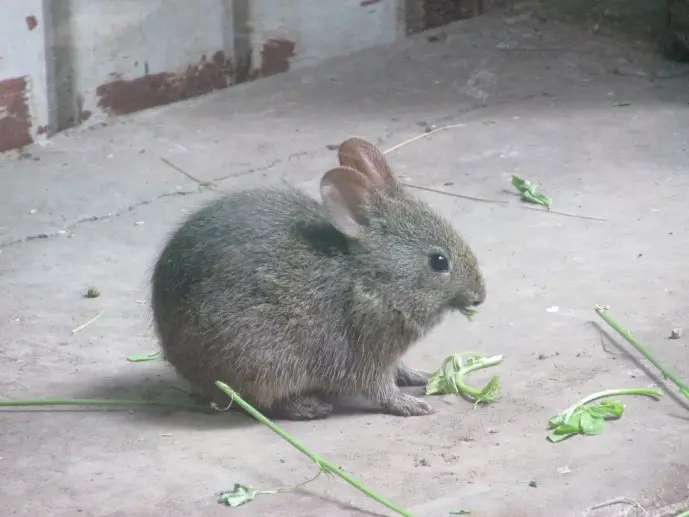
Remember that a Volcano rabbit is a wild rabbit, and even if you have a captive-bred rabbit under your care, this will still be a challenge. This rabbit may be tamed, but this can take time. But no matter what, it’s wild side can still shine through, and this may affect the way you care for this pet.
Taking care of a Volcano rabbit is similar to taking care of other rabbit breeds. Make sure that you’re your pet has the right diet, housing or enclosure, companionship, and medical care or treatment.
An important part of a captive rabbit’s diet is hay. Hay is the bulk of a rabbit’s diet, but you may also feed your pet rabbit pellets. Commercially-prepared food has vitamins and minerals that will enhance your rabbit’s good health. You may also give vegetables and fruits for a well-rounded diet as long as you cut these in small pieces.
Also, give your pets unlimited fresh water and hay. Put water in a heavy shallow dish so your rabbit can easily drink from it. A heavy dish is hard to knock over as your pet moves around its enclosure. An inverted water bottle with a spout at the end is a good way for a pet to drink.
Make sure that your pet is eating the right kind of food. Protect it from pesticides, toxins, and herbicides by providing your rabbit with only organic fruits and vegetables. Also, young rabbits may need alfalfa hay because this is rich in calcium, which is a mineral for growing bones. An adult Volcano rabbit will eat legume hay.
Captive-bred Volcano rabbits are lovable and cute pets, but you must train them well. Remember its wild side? Untrained wild rabbits can revert to its wild nature. So, interact with your pet rabbit by playing with it. Rabbits are social animals and will need companions aside from interacting with their owners.
Volcano rabbits will groom themselves meticulously to the point that it will take so many hours before they’re done. Rabbits may also groom each other and experts to say that this or a way to bond with other rabbits. Also, mother rabbits may be seen grooming her kits during the first hours after birth when she is still in her nest.
Volcano rabbits are most active in the daytime and sleep in the evenings. Therefore, feeding your pet Volcano rabbit should be done in the morning when they are active. Most of the time, captive rabbits sleep 8 hours a day and may sleep huddled together for warmth. When constructing a cage or enclosure for your pet, create a large area where they can eat, play, and sleep.
Supplies and Cages
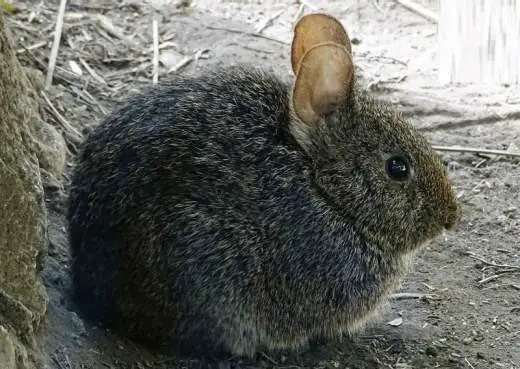
The enclosure for captive Volcano rabbits must be made of wire and have a very strong frame. The bottom must be removable where the rabbit’s droppings will easily fall. This pan makes it easier to clean the cage as well. The floor of the enclosure should be covered by soft bedding so that it is comfortable and warm
You may place a hay feeder on the side of the enclosure. Fill this with hay so your rabbit can eat when it feels hungry. For the cage lining or bedding, you must only use hay, wood pellets, or horse bedding. Never use newspapers, paper towels, or brown paper bags because these can easily tear, will smell, and is not durable.
To clean the cage, remove your pets and secure them in a safe and clean enclosure. Use only a safe cleaner or natural cleaning product like white vinegar, baking soda, and water combination of lemon juice. Avoid using household cleaners such as toilet cleaners, bleach, and detergent soap because these may have toxic ingredients that can be dangerous to your pet’s health.
Consider having a separate or extra cage to breed baby Volcano rabbits. These are born naked, deaf, and blind and need a warm and safe enclosure with the right temperatures. A smaller cage with a cage lamp or lighting will keep kits dry, warm, and safe.
Like other breeds, Volcano rabbits will chew on anything that they can get their paws on. If these rabbits are kept indoors, these will chew on anything made of wood, such as wooden walls, fixtures, and wooden furniture. This rabbit can also chew on electrical wiring, which can lead to electrocution. To prevent accidents, provide hay or chew toys inside its cage. Also, rabbit-proof your home before releasing your pet rabbit from its cage.
Health Concerns

A Volcano rabbit is a healthy breed and is not affected by any disease. This may be due to the rabbit’s rugged habitat. The most common conditions that the Volcano rabbits may be affected are pests such as mites, ticks, and fleas. These pests can be naturally found in their environment.
This rabbit is not immune to common rabbit diseases; therefore, you must always monitor your rabbit’s health and temperament because changes may be due to an illness. As early as your pet can open its eyes, take it to the vet for a thorough check-up and standard vaccinations.
A vet will give your pet some tests. These will assess the overall health and development of your rabbits. Small and young rabbits have sensitive digestive systems and could be prone to different health conditions such as enteritis, bloat, and stasis. These may affect rabbits, which are usually as young as two months of age.
Make sure to watch out for ear or fur parasites. The most common are mites, fleas, and ticks. Rabbits that are affected by these parasites usually have poor hygiene and are kept in dirty surroundings and enclosures.
Monitor your rabbit for any signs of illness such as poor appetite, discharges in the nose and eyes, diarrhea, constipation, and vomiting. You must check for unsteady gait, restlessness, a grating of the teeth, and sleeping for longer periods because these may be signs of a serious condition.
Another important part of taking care of rabbits is deworming. A Volcano rabbit must be treated for worms at least once a year and done during springtime and fall. This is a very important concern especially in rabbits that come from the wild or are bred from wild parents
All rabbit breeds should be dewormed. A deworming paste is the best way to deworm a rabbit. Use only a pea-sized amount. Put this in the rabbit’s mouth, and it will continuously lick and swallow the medication until there’s nothing left. You should follow the dose according to your vet.
Dental Care
Another thing to consider is the rabbit’s teeth. This will continue to grow, and sometimes, this can grow to extreme lengths, which can pierce their gums and mouth, causing pain and discomfort. As an owner, make sure that the rabbit’s teeth will not overgrow.
Give the rabbit hay because this files down the rabbit’s teeth naturally as it chews. Place pieces of wood, wooden baskets, or other accessories that can help file rabbit’s teeth. Regularly monitor your rabbit’s dental health to save on medical and dental bills.
Spaying or Neutering
Rabbits can be very promiscuous, and as an owner, you need to control reproduction by spaying or neutering. You wouldn’t want a home overpopulated with mini rabbits, right?
Spaying and neutering should be done early if you have no plans on breeding rabbits. However, some veterinarians usually do this when the rabbits are six months old to be safe. Bucks are also neutered as young as three months to reduce aggression. For any question about spaying and neutering, talk to your vet for the best advice.
Grooming
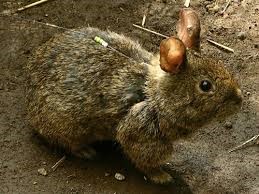
Volcano rabbits have short furs, but still, it will need regular grooming. Brush the fur to keep it clean, shiny, and free from pests. Groom this using a small, sturdy brush at least once or twice a week. You may also run your hand against its fur to remove dirt, especially when it has spent hours outdoors.
Grooming must be done more frequently during the rabbit’s molting period. This will prevent wool blocks and will also keep the rabbit from ingesting their fur. Fur cannot be digested, just like human hair cannot be digested as well. This can accumulate in the digestive tract causing blockage and more complications. So help prevent wool block and groom your pet rabbit regularly.
If your rabbit is very dirty, just use a damp towel to spot clean the dirt away. Just wipe the rabbit down with the damp and never bathe it because this can stress it. Trim your rabbit’s nails monthly and check for overgrown teeth. Also, clean the rabbit’s ears regularly, or you may ask your vet to do this for you if you don’t have the correct tools.
Availability – Where to Get One
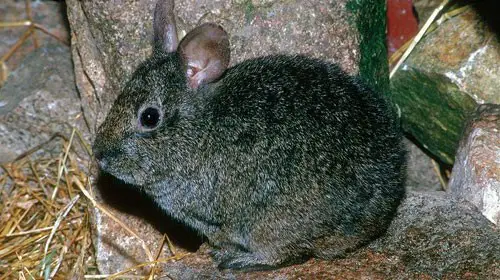
You won’t be able to buy a volcano rabbit from a pet store or a breeder because it is near extinction. You may only chance upon this rabbit if you are hiking along with its natural habitat. But you may still be able to care for this species if you work in a rabbit kennel or breeding area that conserves near-extinct rabbits.
How to Care for a Volcano rabbit
Remember that a wild volcano rabbit is not a pet, and therefore, the care should only be left to experts. This guide is for informational purposes because it is a general guide for all rabbits.
This is a summary of how to care for a Volcano rabbit species. Caring for a Volcano rabbit is like caring for other breeds because it needs four basic elements: a correct diet, housing, companionship (with similar rabbit breeds and with its owner and its family), and medical care.
The main food of captive-bred rabbits is hay. Rabbits can chew this to grind their growing teeth, to keep their digestive system healthy and regular and to keep them occupied when bored. You can feed it pellets that are developed for rabbits, vegetables, and fruits for a well-rounded diet. It is also recommended that you give them food found in their natural habitats such as grasses, twigs, birch, barks, and weeds.
Don’t forget to place fresh water and hay available inside the rabbit’s cage. You must place water in a large, heavy shallow dish so that your rabbit can drink from it, and it won’t knock it over as it moves inside the cage.
Also, captive-bred rabbits can only become a calm, friendly, and docile pet when you take time to train it. It would help a lot if you train and interact with your pet every day too. Also, captive rabbits are social animals and will need a rabbit companion or companions.
If you don’t have space and the patience to care for more rabbits, then a rabbit may not be an appropriate pet. It needs a company, not just human companionship. Take note that your pet can grow healthy, with good docile temperament when it socializes with cage mates and its owner.
Always take your pet to the vet because it needs vaccinations, tests, and a clean bill of health before you can let it associate with other rabbits, other pets at home, and you and your family. Take note of the many signs of illness in rabbits and take it to the vet for proper care.
FAQs
Where do Volcano rabbits live?
Volcano rabbits live in burrows and holes, as well as in thick vegetation in Mexico. But in captivity, this rabbit lives in cages and comfortable enclosures where they are lovingly cared for by dedicated owners.
Do Volcano rabbits have good hearing?
Despite the small ears of the Volcano rabbit, this has good hearing. It can hear its predators from far away, and this allows them to hide or avoid the threat.
How young do you spay or neuter your pet rabbit?
The younger, the better, they say, but this may depend on your vet’s assessment. Some bucks are spayed as young as 3 months, while some will wait till these are 5 to 6 months before neutering.
What do Volcano rabbits eat?
Volcano rabbits are herbivorous, just like its captive and domesticated cousins. These will eat all plant parts such as roots, bark, seeds, flowers, and leaves, but in captivity, it can eat commercially-prepared rabbit food or pellets, small servings of vegetables and fruits.
How large should a Volcano rabbit’s cage be?
A Volcano rabbit is small, but it needs a large enclosure because of its energetic nature. For two large rabbits, double this area. Don’t overlook the size and al-ways make sure that your rabbits have enough space to play, eat, and sleep.
Are Volcano rabbits endangered?
Yes, the Volcano rabbit is listed as an endangered species, but conservation efforts are being made to protect its last population in the wild areas of Mexico. Also, there are reports that breeding Volcano rabbits in captivity are a success.
Can Volcano rabbits swim?
Yes, Volcano rabbits can swim similar to most rabbit breeds, but this may not be as good as other animals. Also, water is stressful to rabbits and so is bathing so you must never bath it.
Can you tame a wild rabbit?
A wild rabbit cannot be tamed, and this is not recommended. You might end up getting hurt since wild rabbits can be nervous and skittish and may bite you. On the other hand, you can train a captive-bred rabbit instead because most captive rabbits have a docile behavior and are calmer than wild rabbits. However, these may need constant handling and interaction to remain tame, happy, and healthy, even in captivity.
Will Volcano rabbits eat fruits and vegetables?
Yes, Volcano rabbits can eat fruits and vegetables in the wild and captivity. Aside from these, you may also feed your Volcano rabbits commercially-prepared pellets or rabbit food that contain nutrients that your pet needs as it grows healthy and happy.
Will Volcano rabbits eat their poop?
Volcano rabbits may eat their poop because these still have nutrients in them. But after doing this once, they won’t do it the second time. No one knows why rabbits do this, and you can prevent this by removing their droppings ASAP.
Can you keep two or more Volcano rabbits in one cage?
Yes, you can keep two or more rabbits in one cage as long this enclosure is large enough for them. Take note that the cage should be large, comfortable, and safe so your rabbit or rabbits can be inside comfortably.
How do you clean and maintain the Volcano rabbit’s cage?
First, remove the rabbit inside the cage and place it in a clean and safe cage, box, or container. Remove the pan where the poop is and dispose of the droppings properly. Hose the cage down and use a brush and cleaning product to clean the cage walls, bottom, accessories, and toys. Finally, make sure that everything is dry before placing your pet back inside its cage.
How do you take care of baby Volcano rabbits?
If you want to care for Volcano rabbits, put the kits in a separate comfortable and warm cage. Feed the newborn rabbits soft, pureed food, and keep these warm and safe always. Protect these from predators, even from your pet cat or pet dog. For wild-caught bunnies, call animal services for proper care.
Can you allow Volcano rabbits indoors to play in your home?
You may let a rabbit to stay indoors but only under constant supervision. A portable perimeter fence will help cordon off areas that the rabbit can’t go. You must rabbit-proof your home before you let your rabbits out of their cage, whether indoors or outdoors.
Where do you place a Volcano rabbit’s cage, indoors, or outdoors?
The location of a Volcano rabbit’s cage may depend on your preference. You may place the cage indoors to protect it from rain and the sun, but most indoor cages may be too small and may not be enough for several adult rabbits. When you construct your cage outdoors cage, the rabbits may need to bear with the elements, but at least they will have a large area for playing and socializing.
Do you need to place a heater inside a Volcano rabbit’s cage?
Use a cage lamp to provide heat. But in extremely cold climates, use a small portable heater and place this near the rabbit cage for a comfortable place for your pet rabbits and also for incubating kittens.
Will a mother Volcano rabbit eat her young?
Some species will eat their young. Breeders say that if you spot a captive rabbit doing this, separate it and never let it breed again.
Can rabbits survive the cold?
Yes, rabbits may remain in the cold and survive by looking for food that’s under the snow. Even rabbits as small as a Volcano rabbit can use their short legs to dig out snow and eat unfrozen roots, shrubs, berries, and other edible morsels of food that they can find.
Can you keep a Volcano rabbit as a pet?
Yes, you can keep a Volcano rabbit as a pet, but only when it has been properly trained, and you have earned its trust.
Are Volcano rabbits territorial animals?
Volcano rabbits may become territorial when these are placed in a small cage or enclosure. Males can become aggressive and can become very dangerous to other males during the breeding season. These can bite, scratch, and kick their opponents in a battle of hierarchy.
Should you rescue a wild rabbit from the forest?
Never get a wild animal like a rabbit from the forest. You won’t be able to tame it and make it your pet because it will remain wild. When you spot an injured wild rabbit, call animal services for help right away.
Are Volcano rabbits carnivorous animals?
No, these are not carnivorous and are herbivores, which means that these will never eat meat. These rabbits will only consume plants or plant parts such as roots, bark, leaves, stems, seeds, and so many more. In captivity, these will eat only pellets (commercially-prepared food, vegetables, and fruits).
Can Volcano rabbits live outdoors?
A pet Volcano rabbit may be allowed to remain outdoors, but you must rabbit-proof your yard first. A removable perimeter fencing is a good way to limit the area where the rabbit can move around on their own. Bury the poles and the edges of the fence to prevent the rabbit from digging out of the cage.
What happens when the teeth of a rabbit grow longer?
When the teeth of the rabbit become too long, these can pierce its gums and its mouth, causing a lot of pain and can also affect its appetite. This is why your pet rabbit must see a dentist regularly. You can also help your pet by feeding it hay because this grinds the teeth shorter when it chews.
Can pet rabbits like Volcano rabbits tolerate children?
Some rabbits are very skittish and may not be comfortable with being held by young children. Meanwhile, some rabbits are calm, docile, and friendly and will love to be held and petted by their owners and by young kids.
Will your pet rabbit live in a cold area?
Rabbits do not hibernate, and some species can survive the cold by foraging food under the snow. Some rabbits can also change their fur color to adapt to the winter weather.
Can you place the cage of this rabbit near other rabbit pets?
Yes, you can do this, and there won’t be a problem because this is the actual setup in most pet shops. Volcano rabbits can be skittish but may warm up with their owners when properly trained.
How often do rabbits should go to the vet?
Rabbits should be taken to the vet at least once a year. Young rabbits must be vaccinated against diseases as early as possible, and these must have an initial visit to a vet when they are just a few weeks old to rule out illnesses and to diagnose other conditions early.
Are Volcano rabbits bites dangerous?
Yes, Volcano rabbit bites and the bite of all rabbit breeds are dangerous because these may have rabies. Also, rabbit teeth are huge and can easily tear off the flesh, which can lead to an infected wound.
Can Volcano rabbits escape their cages?
Yes, Volcano rabbits can escape their cages by burrowing or by destroying and chewing screens, wooden posts, and other light materials
Can you prevent a Volcano rabbit from eating his poop?
You can stop a rabbit from eating its poop by removing the poop right away, but of course, you can’t watch your rabbits all day just to remove their droppings. No matter what, these animals will still eat their droppings because they know that it still has nutrients in them.
Can rabbit diseases harm humans?
Some rabbit diseases can affect only rabbits, while some can also cause illness in humans. If your rabbit is sick, you should take it to the vet quickly to get proper treatment. You must check the different signs of illnesses such as poor appetite, diarrhea, constipation, sneezing, changes in breathing, and changes in behavior.
Can you train your rabbit to wear a collar and walk on a leash?
Some pet owners are successful in training their pet rabbits to wear a collar and to walk on a leash, but some say that this is hard to do, and it may depend on the rabbit breed.
Will Volcano rabbits recognize their owners?
Some rabbit owners say that their pet rabbits can recognize them. Also, these can tell if they are being handled by their owners or by other people.
What to do with abandoned baby rabbits?
If wild kits are abandoned in their nests, contact animal service right away. You should never get baby rabbits from the wild to keep as pets.
How many rabbits can you keep as a pet?
You can keep more rabbits as a pet as long as you have a large enclosure to keep these rabbits comfortable and happy. Keeping only one rabbit will make it lonely and will only make it sick and depressed because rabbits are social animals.
Will rabbits eat insects?
No, rabbits won’t eat insects because this animal will eat only plant and plant parts, rabbit pellets, fruits, and vegetables. Don’t forget that organic produce is the best to avoid chemicals and toxins that can harm your rabbit.
Can rabbits see well in the dark?
Yes, rabbits have good vision at night. This is why some species prefer to look for food or forge at night. Rabbits like the Volcano rabbit also have a good sense of smell and hearing to allow them to recognize predators that are nearby.
Are all rabbits cannibals?
Eating their babies is seen in some rabbit breeds, and experts say that this happens because the female is hungry or thirsty after giving birth. Also, this is a way to remove any tissue, blood, and smell in the nest when the baby rabbit is stillborn.
Where do wild rabbits sleep?
In the wild, rabbits may sleep inside burrows or warrens. They dig holes as deep as several inches to be there all day. Rabbits can sleep in dens, and they may also give birth to their young here. In captivity, they live in an enclosure that can accommodate a group of rabbits where they are safe from predators.
